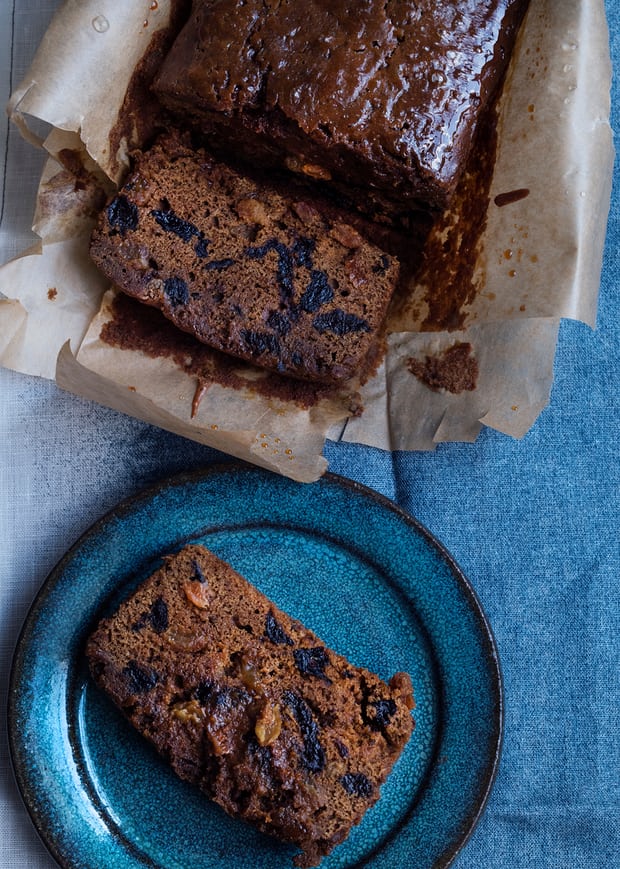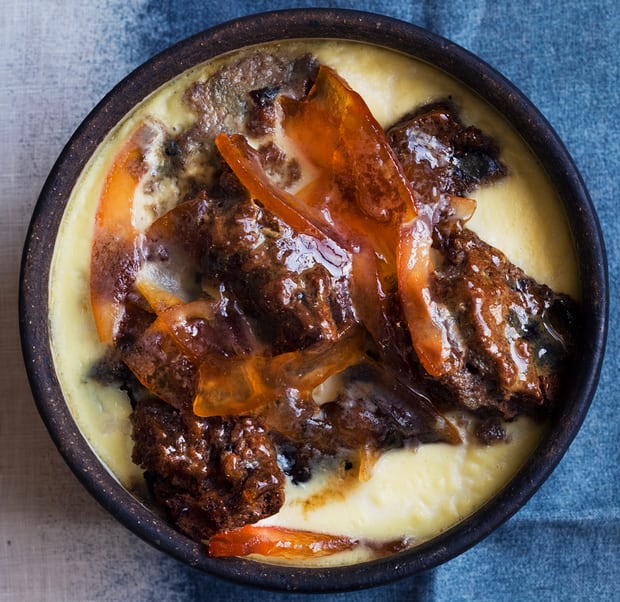Nigel Slater's malt loaf recipes
Malt loaf, for Nigel, has Proustian qualities: it's a culinary key to times past. Here's how to make it – and what to do with it

Dark materials: Nigel Slater's malt loaf recipe. Photograph: Jonathan Lovekin for the Observer
I have no idea when I stopped eating malt loaf; I only know that I did. Perhaps it was its resolutely unfashionable character that sent me looking elsewhere. Or the fact that tracking it down was getting more difficult with each passing year. More likely, I gave up the damp, deliciously fruit-laden loaf because other more exciting things got in the way.
And then, out of nowhere, I got a fancy to rekindle our old friendship. I longed for a thin slice of buttered malt loaf, the slightly tacky feel on my fingers, that smell of dried fruit and tea I once held so dear. I wasn't sure it would be quite the same stripped of the traditional waxed paper wrapper of the commercial brands, like a Kit Kat without the silver foil. Yet one sniff of the baked loaf – think fruitcake meets Ovaltine – and all the good stuff came floating back. Malt loaf is something of a safe harbour, a cloud of raisin and malt-scented nostalgia, in a complicated world. It tastes of home, of ticking clocks and quality time spent with your gran. At least it does for me.
The method is straightforward, a recipe anyone can attempt, but it is worth noting that the texture of the uncooked cake mixture is akin to that of raw gingercake. In other words a soft batter you can almost pour into the tin, rather than stiff and creamy like the texture of uncooked fruitcake. Sometimes you have to trust a recipe rather than follow your own intuition.
Malt loaf is something of a keeper. Wrapped in foil and stored in a cool corner of the kitchen it will not only keep for a few days but will be better for it. Like Christmas cake, this fruit-packed loaf matures benignly. It is a good idea to brush the outside of the freshly baked bread with some of the malt extract directly from the jar. The sweet, mahogany-brown goo will be partially absorbed by the loaf, giving the characteristic tackiness that should come part and parcel of such a recipe. A recipe that takes you back to simpler, gentler times. Sometimes you can have too much excitement.
Malt loaf
Malt extract is still around, but you may have to go to a large supermarket or wholefood store for it. If the surface of the loaf browns more quickly than you'd like it to, cover with foil for the last few minutes of cooking. You will need a little more malt extract at the end for brushing over the surface of the warm cake, to create a sticky crust.
To finish:
You will also need a deep, rectangular cake tin measuring 20x9cm (measured on the base) lined with baking paper.
Preheat the oven to 160C/gas mark 3. Put the malt extract, muscovado sugar and black treacle in a small saucepan and warm, without stirring, over a moderate heat until the sugar has dissolved.
Sift the flour, baking powder and salt to combine thoroughly in a large mixing bowl. Chop the prunes into small pieces.
Pour the warm malt and sugar mixture into the flour, together with the tea. Break the eggs into a small bowl, beat lightly with a fork and fold into the batter with the chopped prunes and the sultanas.
Scoop the mixture – it is quite soft – into the lined cake tin and gently smooth the surface.
Bake for 1 hour until lightly springy, then remove from the oven and leave to cool in the tin. While the cake cools, brush the surface with a little more malt extract.

'Serve the pudding warm, as you would a quiche. It's nicer that way': Nigel Slater's marmalade malt loaf pudding recipe. Photograph: Jonathan Lovekin for the Observer
Marmalade malt loaf pudding
I have known people to make this nursery pudding with cold milk rather than hot, but I think that's a mistake. It takes an age for the milk to heat up from cold once in the oven – far better to bring it almost to the boil first. You don't have to use malt loaf, by the way. Bread or panettone works nicely with the marmalade, too. If you are using bread cut from a plain white loaf then I suggest some butter on it as well. About 75g should do it. Note my suggestion to serve the pudding warm, as you would a quiche. It's not just nicer that way – the custard needs that amount of time to settle.
Preheat the oven to 160C/gas mark 3. Slice or tear the malt loaf into pieces. Spread each piece with marmalade then pack them loosely into a baking dish with enough room round them for the custard.
Put the milk and cream in a saucepan, add the cinnamon and sugar and bring almost to the boil. (I try to catch it just before it starts to rise up the sides of the saucepan.) Break the eggs into a jug or mixing bowl then pour the hot milk mixture into them, stirring continuously.
Pour the custard over the malt loaf then let it soak in for 10 minutes. Finely grate a light dusting of nutmeg over the surface of the custard.
Bake for 45-50 minutes, until the custard is set but still shivers when you gently shake the dish. Remove from the oven and leave for a good 20 minutes or more to calm down.
I should add that this is also rather wonderful served very cold, with a jug of cream.
Email Nigel at nigel.slater@observer.co.uk or follow him on Twitter @NigelSlater